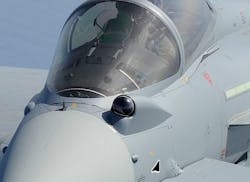Infrared search and track (IRST) technology gives jet fighter aircraft stealthy vision
NERVIANO, Italy – Look on the nose of many modern jet fighter aircraft such as the Eurofighter Typhoon and you’ll spot a large bulbous protrusion coming from just near the cockpit. Air Force Technology reports. Continue reading original article
The Military & Aerospace Electronics take:
11 March 2019 -- While it has a rather unassuming appearance, this aperture forms an important role in the fighter’s detection and fire control functionality, acting like a powerful thermal camera to spot distant enemy targets and using that data to neutralize the threat.
The beauty of infrared search and track technology (IRST) technology is it is completely passive and does not highlight the location of the aircraft, unlike when a pilot decides to use the on-board radar, which can give away its position as radio frequency energy bursts out. IRST can also work in all weather conditions as it uses the infrared rather than the visible part of the electromagnetic spectrum.
So important is this stealthy capability, particularly as China and Russia develop their own stealth aircraft with advanced detection capabilities, that the US is retrofitting many of its advanced fighter aircraft – including the navy’s F/A-18E/F Super Hornet and the air force’s F-15 Eagle – with an IRST capability. It is hoped that with these new “eyes” Western fighter jets will be able to sense adversary aircraft first and kill them before being seen themselves.
Related: How Russia or China could use counter-stealth IRST to shoot down America's stealth fighters
John Keller, chief editor
Military & Aerospace Electronics
Ready to make a purchase? Search the Military & Aerospace Electronics Buyer's Guide for companies, new products, press releases, and videos

